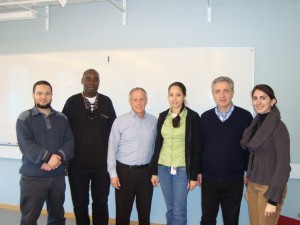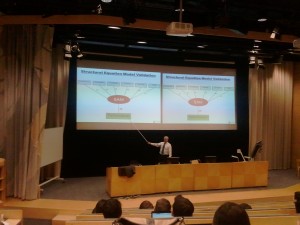On Wednesday I presented the paper “E-Service requirements from a consumer-process perspective” on the 17th International Working Conference on Requirements Engineering: Foundation for Software Quality (REFSQ 2011). This year REFSQ was held in Essen, Germany. The presented paper, written together with Erik Perjons, describes an approach for e-service problem and solution discovery based on the analysis of the service consumers business processes. The paper was written as a part of the SamMET research project. Read more about the SamMET project at dsv.su.se/sammet
Michael ‘Monty’ Widenius visits SYSLAB
‘Monty’ Widenius, founder of the world’s most widely used RDBMS — MySQL — visited SYSLAB today.
 MySQL was recently aquired by Oracle Corporation with the consequence that the way by which its produced and marketed is rapidly changing.
MySQL was recently aquired by Oracle Corporation with the consequence that the way by which its produced and marketed is rapidly changing. Currently Monty heads a company called Monty Program that organises the development of MariaDB, a drop-in replacement for MySQL. The production of MariaDB follows the old MySQL tradition of agility, to be free and open source (yes, there is a difference!), and providing for the needs of users.
Currently Monty heads a company called Monty Program that organises the development of MariaDB, a drop-in replacement for MySQL. The production of MariaDB follows the old MySQL tradition of agility, to be free and open source (yes, there is a difference!), and providing for the needs of users.

The half Monty
Discussions revolved around how MariaDB could be used in the courses given at SYSLAB and how closer collaborations could be established.
It was a very pleasurable and informative meeting.
Meeting of IT Management Group with Professor Jerry Luftman
On March 22, 2011 the IT Management group has discussed their research work with Professor Jerry Luftman. In the meeting we had a fruitful discussion about how should we develop our research and also about possibilities to cooperate in the research area of Business-IT Alignment. Professor Jerry Luftman has shown to have an interest in our research work and has given us many good ideas to explore. A picture from this meeting with Professor Jerry Luftman you could find below.
Paper accepted in EMMSAD 2011 Conference
A paper titled “Analyzing the Integration between Requirements and Models in Model Driven Development” has been accepted for the EMMSAD 2011 Conference (http://www.emmsad.org/), which is held in conjunction with CAiSE 2011 in London, UK.
Authors: Iyad Zikra, Janis Stirna, Jelena Zdravkovic
Abstract: In Model Driven Development (MDD), models replace software code as the development artifact. At the same time, requirements represent the information that is elaborated in models. However, despite the tight relationship between models and requirements, only a few MDD approaches provide the necessary methodological guidelines and tool support to explicitly facilitate this relationship. In this paper, we analyze existing approaches for integrating requirements with models within MDD. Based on the analysis, we elicit a set of general properties that need to be fulfilled when considering the integration of requirements and models, and we assess the contribution of the considered approaches accordingly.
Open Seminar with Professor Jerry Luftman on March 21, 2011
At the invitation of IT Management group within SYSLAB Professor Jerry Luftman has given on March 21, 2011 in Forum – Aulan an open seminar. A short description of the seminar topic and information about our distinguish guest speaker including his presentation you could find below.
Topic: IT-Business Strategic Alignment Maturity
The beginning of the 21st Century is marked by the continued penetration of Information Technology (IT) into all facets of the organization. Businesses, regardless of their size, cannot function without IT enabling/driving every activity, from traditional systems such as e-mail, accounting, payroll, and inventory management, to strategic applications that interact with customers and partners. In spite of recognizing the above, for over 30 years, aligning IT and business organizations have remained a pervasive and persistent problem. Professor Luftman has created an assessment of the maturity of this important relationship; in fact he has conducted assessments from over one-third of the global 1,000 companies. The purpose of this seminar will be to introduce attendees to the model and present some of the important benchmarking insights that have resulted from Professor Luftman’s research.
Speaker:
Professor Jerry Luftman is a Distinguished Professor at Stevens Institute of Technology New-York, USA, Wesley J. Howe School of Management. He is the founder and Executive Director of the Howe School’s Graduate Information Systems Programs. Professor Jerry Luftman’s career includes strategic positions in management (Information Technology and consulting), management consulting, Information Systems, and education. Dr. Luftman’s experience combines the strengths of practitioner, consultant, and academic. His proficiency in business-IT alignment, books, published research, consulting and teaching/speaking engagements further exemplify Dr. Luftman’s expertise and leadership in his field. After a notable twenty-two year career with IBM, he is currently a Distinguished Professor at Stevens Institute of Technology School of Management.
The pdf file of Professor Jerry Luftman’s presentation you could find here Luftman SAM MATURITY Stockholm
Professor Michaël Petit in SYSLAB this week!
During this week Prof. Michaël Petit from University of Namur (Belgium) is going to continue his collaboration with our research lab. This time the effort is set on an integration of well-established Business Strategy approaches such as Strategy Maps, Value Chain, Blue Ocean and others for a better understanding of their use in the requirements engineering scope. From our side, Paul, Constantinos, Birger and Jelena are engaged in the work.
2 Contributions accepted for IEEE RCIS 2011
The research papers of our PhD students, Khurram Shahzad and Constantinos Giannoulis have been accepted for the 5th IEEE International Conference on Research Challenges in Information Science (RCIS 2011). Short summaries of their works, the first on a process analysis approach using warehouses, and the other on business strategy modelling, are provided below:
Towards Goal-driven Access to Process Warehouse: Integrating Goals with Process Warehouse for Business Process Analysis (Shahzad, Zdravkovic)
Analysis and improvement of business processes, one of the core phases in the BPM life cycle, is becoming on top of the agenda for many enterprises and organisations. An emerging approach to analyze business processes is to use the business intelligence approaches that attempt to facilitate the analytical capabilities of business process management systems by employing process-oriented data warehouse and decision making techniques. However, very little work has been done on employing a business orientation in the design and utilization of process warehouse. The approach presented in this paper, addresses that limitation by attempting to integrate business goals with warehouse. The proposed approach to integration spans across two levels, conceptual and implementation; the first defines the concepts that are used to relate goals and process warehouse; the latter is used to implement the concepts and the relations to link warehouse data and goal records for relational databases. The latter is used identify the records that are related with goals. The proposed approach enhances the way users access warehouse data and interpret the data. To facilitate the use of the proposed approach we have developed a prototype. The evaluation results, though preliminary, provides evidence of the usefulness of our approach.
Modeling Business Strategy: A meta-model of Strategy Maps and Balance Scorecards (Giannoulis, Petit, Zdravkovic)
Business strategy is aimed to support the vision of an enterprise, by paving the way to achieve it through goals that direct the strategy’s execution. However, there is a lack of means to establish and assess the alignment of business strategy and goal oriented requirements engineering. The objective of our ongoing research is to model business strategy in order to establish well-defined and traceable links with system requirements. In this paper, we propose a business strategy meta-model for Strategy maps and Balance Scorecards. The validity and applicability of the meta-model is demonstrated through a case scenario using OWL and Telos.
Funding accepted for exchange of researchers with University of California, San Diego
Sumithra Velupillai, fil.lic, obtained funding from Stockholm University for cooperation with the research group of associate professor Wendy Chapman at University of California, San Diego, (UCSD), USA.
The funding will be used for exchange of researchers between IT for Health, DSV and the UCSD School of Medicine’s Division of Biomedical Informatics, San Diego, USA. The research area is Health Informatics and specifically clinical text mining.
The research cooperation will start in May 2011 and carry on until December 2013.
Congratulations Sumithra!

